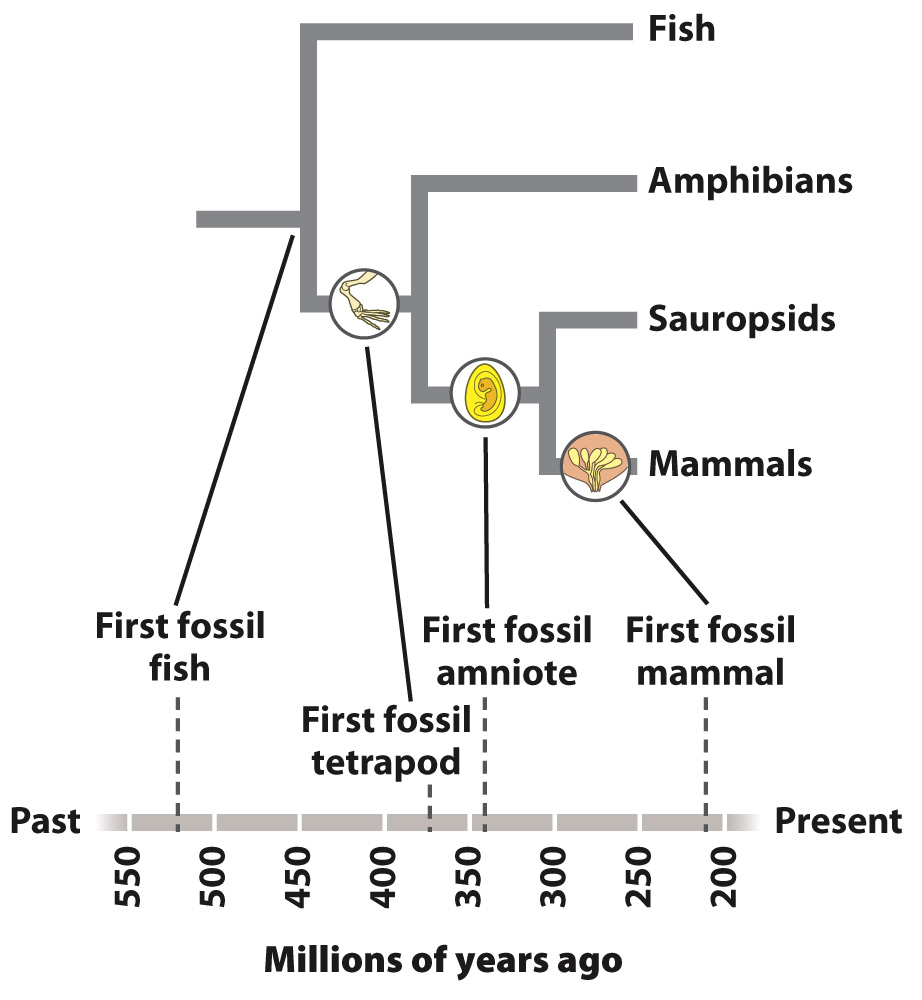Agreement between phylogenies and the fossil record provides strong evidence of evolution.
Phylogenies based on morphological or molecular comparisons of living organisms make hypotheses about the timing of evolutionary changes through Earth history. We humans are a case in point. As we discuss in Chapter 24, comparisons of DNA sequences suggest that chimpanzees are our closest living relatives. This is hardly surprising, as simple observation shows that chimpanzees and humans share many features. However, among other differences, chimpanzees have smaller stature, smaller brains, long arms that facilitate knuckle-
How did these differences accumulate over the 7 million years or so since the human and chimpanzee lineages split? Fossils painstakingly unearthed over the past century show, for example, that the ability to walk upright evolved before the large human brain. Lucy, a famous specimen of Australopithecus afarensis dating to about 3.2 million years ago, was fully bipedal but had a brain the size of a chimpanzee’s. Fossils like Lucy that are a mix of ancestral (brain size) and derived (bipedalism) characters provide strong support for our phylogenetic tree that shows that humans and chimpanzees are sister taxa.

The agreement of comparative biology and the fossil record can be seen at all scales of observation. Humans form one tip of a larger branch that contains all members of the primate family. Primates, in turn, are nested within a larger branch occupied by mammals, and mammals nest within a still larger branch containing all vertebrate animals, which include fish. This arrangement predicts that the earliest fossil fish should be older than the earliest fossil mammals, the earliest fossil mammals older than the earliest primates, and the earliest primates older than the earliest humans. This is precisely what the fossil record shows (Fig. 23.22).
The agreement between fossils and phylogenies can be seen again and again when we examine different branches of the tree of life or, for that matter, the tree as a whole. All phylogenies indicate that microorganisms diverged early in evolutionary history, and mammals, flowering plants, and other large complex organisms diverged more recently. The tree’s shape implies that diversity has accumulated through time, beginning with simple organisms and later adding complex macroscopic forms.
The geologic record shows the same pattern. For nearly 3 billion years of Earth history, microorganisms dominate the fossil record, with the earliest animals appearing about 600 million years ago, the earliest vertebrate animals 520 million years ago, the earliest tetrapod vertebrates about 360 million years ago, the earliest mammals 210 million years ago, the earliest primates perhaps 55 million years ago, the earliest fossils of our own species a mere 200,000 years ago. Similarly, if we focus on photosynthetic organisms, we find a record of photosynthetic bacteria beginning at least 3500 million years ago, algae 1200 million years ago, simple land plants 470 million years ago, seed plants 370 million years ago, flowering plants about 140 million years ago, and the earliest grasses 70 million years ago.
In Part 2, we explore the evolutionary history of life in some detail. Here, it is sufficient to draw the key general conclusion: The fact that comparative biology and fossils, two complementary but independent approaches to reconstructing the evolutionary past, yield the same history is powerful evidence of evolution.